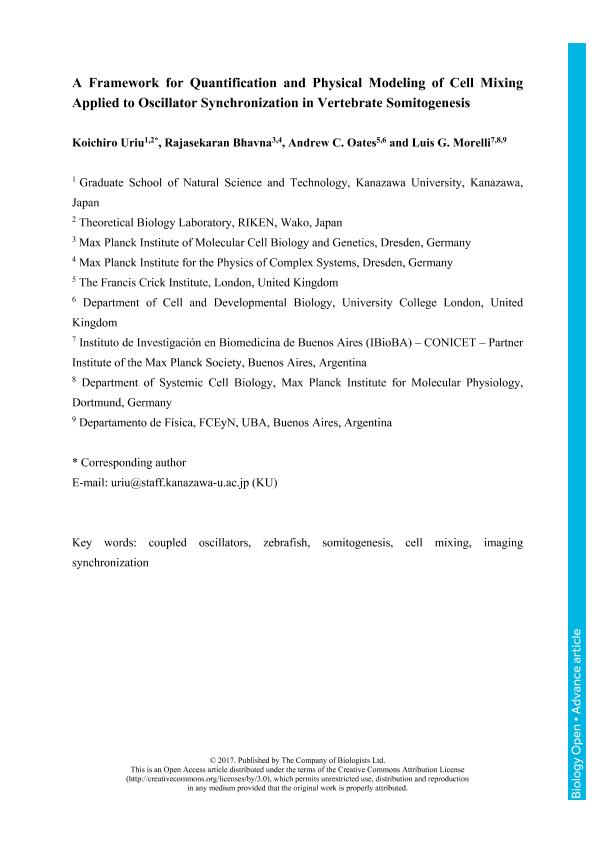Mostrar el registro sencillo del ítem
dc.contributor.author
Uriu, Koichiro

dc.contributor.author
Bhavna, Rajasekaran
dc.contributor.author
Oates, Andrew C.

dc.contributor.author
Morelli, Luis Guillermo

dc.date.available
2018-06-22T21:26:25Z
dc.date.issued
2017-08
dc.identifier.citation
Uriu, Koichiro; Bhavna, Rajasekaran; Oates, Andrew C.; Morelli, Luis Guillermo; A framework for quantification and physical modeling of cell mixing applied to oscillator synchronization in vertebrate somitogenesis; Company of Biologists; Biology Open; 6; 8; 8-2017; 1235-1244
dc.identifier.issn
2046-6390
dc.identifier.uri
http://hdl.handle.net/11336/49814
dc.description.abstract
In development and disease, cells move as they exchange signals. One example is found in vertebrate development, during which the timing of segment formation is set by a ‘segmentation clock’, in which oscillating gene expression is synchronized across a population of cells by Delta-Notch signaling. Delta-Notch signaling requires local cell-cell contact, but in the zebrafish embryonic tailbud, oscillating cells move rapidly, exchanging neighbors. Previous theoretical studies proposed that this relative movement or cell mixing might alter signaling and thereby enhance synchronization. However, it remains unclear whether the mixing timescale in the tissue is in the right range for this effect, because a framework to reliably measure the mixing timescale and compare it with signaling timescale is lacking. Here, we develop such a framework using a quantitative description of cell mixing without the need for an external reference frame and constructing a physical model of cell movement based on the data. Numerical simulations show that mixing with experimentally observed statistics enhances synchronization of coupled phase oscillators, suggesting that mixing in the tailbud is fast enough to affect the coherence of rhythmic gene expression. Our approach will find general application in analyzing the relative movements of communicating cells during development and disease.
dc.format
application/pdf
dc.language.iso
eng
dc.publisher
Company of Biologists

dc.rights
info:eu-repo/semantics/openAccess
dc.rights.uri
https://creativecommons.org/licenses/by/2.5/ar/
dc.subject
Cell Mixing
dc.subject
Coupled Oscillators
dc.subject
Imaging Synchronization
dc.subject
Somitogenesis
dc.subject
Zebrafish
dc.subject.classification
Otras Ciencias Biológicas

dc.subject.classification
Ciencias Biológicas

dc.subject.classification
CIENCIAS NATURALES Y EXACTAS

dc.title
A framework for quantification and physical modeling of cell mixing applied to oscillator synchronization in vertebrate somitogenesis
dc.type
info:eu-repo/semantics/article
dc.type
info:ar-repo/semantics/artículo
dc.type
info:eu-repo/semantics/publishedVersion
dc.date.updated
2018-06-19T15:55:39Z
dc.journal.volume
6
dc.journal.number
8
dc.journal.pagination
1235-1244
dc.journal.pais
Reino Unido

dc.journal.ciudad
Cambridge
dc.description.fil
Fil: Uriu, Koichiro. Kanazawa University; Japón
dc.description.fil
Fil: Bhavna, Rajasekaran. Max Planck Institute of Molecular Cell Biology and Genetics; Alemania. Max Planck Institute for the Physics of Complex Systems; Alemania
dc.description.fil
Fil: Oates, Andrew C.. Francis Crick Institute; Reino Unido. University College London; Reino Unido
dc.description.fil
Fil: Morelli, Luis Guillermo. Consejo Nacional de Investigaciones Científicas y Técnicas. Oficina de Coordinación Administrativa Parque Centenario. Instituto de Investigación en Biomedicina de Buenos Aires - Instituto Partner de la Sociedad Max Planck; Argentina. Max Planck Institute for Molecular Physiology; Alemania. Universidad de Buenos Aires. Facultad de Ciencias Exactas y Naturales. Departamento de Física; Argentina
dc.journal.title
Biology Open
dc.relation.alternativeid
info:eu-repo/semantics/altIdentifier/url/http://bio.biologists.org/content/6/8/1235
dc.relation.alternativeid
info:eu-repo/semantics/altIdentifier/doi/http://dx.doi.org/10.1242/bio.025148
Archivos asociados
